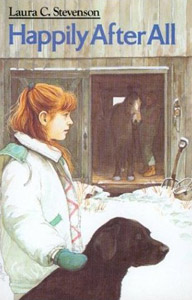A New Series: One Minute Reviews of
Books by Vermont Authors
Laura's column "One Minute Reviews" has appeared bi-weekly in Wilmington, Vermont's Deerfield Valley News since 2015. In April 2018, she found that no Vermont periodical consistently reviews all commercially published fiction and non-fiction by Vermont authors, so she started a series to fill that void. Published reviews from that series and some earlier reviews of local authors are listed with links to a scan of the printed copy. Reviews still in queue are listed without links until they appear in print.
The books reviewed in this series are available through Wilmington's Pettee Memorial Library, the Whitingham Free Public Library, and locally owned Bartleby's Books in Wilmington.
Deerfield Valley News, 7/22/2021
Memoir and a Picture Book for Gardeners
Liza Ketchum, The Last Garden, illustrated by Bobbi Angell. Shires Press, 2021
Liza Ketchum, Jaqueline Briggs Martin, Phyllis Root; Claudia McGhee, illustrator, Begin with a Bee. University of Minnesota Press, 2021
When Liza Ketchum and her husband bought a Dorset farmhouse that was once briefly owned by her parents, she set to work resurrecting its overgrown yard—reflecting that she was probably creating her last garden. Her husband was appalled by the phrase: “What do you mean: ‘The last garden?’ Are you planning to die soon?” She wasn’t, but she understood that when one reaches a certain age, a garden, with its numerous transplants from earlier gardens and gifts from gardening friends, conjures up memories of years long past. The Last Garden is thus a memoir focused not on Ketchum’s long career as a teacher and the writer of eighteen books, but on flowers, shrubs and trees that evoke moments in her life. Every chapter title is a flower’s name, and each of the flowers named is accompanied by a monochrome portrait beautifully drawn by Bobbi Angell. The rest of the chapter links that flower to the person with whom Ketchum has long associated it. Timothy, for example, brings back a memory of “driving” a hay wagon when she was four, safe on the lap of a farming neighbor; peonies raise memories of her parents; as for petunias, she has never planted them since her grandmother made her deadhead all the petunias in a large rock garden as punishment for holding a party on the family property when her parents were away.
While the memoir portrays gardens as various as Ketchum’s paternal grandparents’ garden in Florida, Nancy Lancaster’s famous English Country Garden in Oxfordshire, and the city garden Ketchum and her second husband created in Watertown, the book as a whole is deeply embedded in Vermont. As a child, Ketchum spent every summer at Brook House, the Vermont estate owned by her maternal grandmother, surrounded by gardens that were carefully tended by Artie, a gardener who was also a painter. In the early 1970s, she and her first husband lived in Marlboro, and gardened part of a sixty-one-acre property filled with rocks. There, when she called Alice Holway for advice, she was given (perhaps “bequeathed” is a better word) “Alice’s rose,” whose picture graces the book’s cover. It’s a climbing bramble, thorny, and so determined to survive that it needs to be severely pruned. But for a few weeks a year, it blooms beautifully, and when Ketchum left Marlboro, she managed to save a piece of the rose—and some years later, to plant it in a tiny city garden in Watertown before bringing it to Dorset and the last garden.
Ketchum’s memoir is inspirational, for her gardening—always organic—is part of what she calls the Wheel of Life, in which plants support creatures that in turn support plants. A citizen scientist, Ketchum has learned a great deal about pollinators, especially hummingbirds, butterflies and bees. Her knowledge of the last has led her to join with three colleagues in Begin with a Bee, a beautifully illustrated picture book that follows the life cycle of the endangered Rusty-Patched Bumble Bee. The child (and adult) who reads this book watches the Queen Bee emerge from her underground nest in early spring and create, “all by herself” a whole colony of bees, whose larvae she feeds with the nectar and pollen she has gathered from emerging flowers. As the informative material at the end of the book points out, it is the very solitary nature of the Queen’s achievement that makes Rusty-Patch Bees so vulnerable to extinction: to kill a Queen is to kill a whole colony. Children who turn this book’s pages will learn how important pollination is, and they may come to see bees not as terrible bugs that sting, but as what they are: essential participants in the Wheel of Life.
These two beautiful books make wonderful reading, bringing memories, gardening lore, and scientific understanding to all who admiringly turn their pages.


